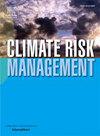Meteorological disasters, downside risk of grain yield and mitigation effect of high-standard farmland construction policy in China
Abstract
The exploration of ways to reduce the downside risk of grain yield posed by meteorological disasters has become a primary task in China. This study employs a moment-based model to estimate the downside risks of maize, rice, and wheat yields. It further analyses the risk mitigation effects of implementing a high-standard farmland construction policy in China using a continuous difference-in-differences (DID) model and Chinese provincial data from 2005 to 2017. The results show that the downside risk of wheat yield but not of maize or rice yield increases when meteorological disasters are considered, implying that wheat is more vulnerable to the adverse effects of meteorological disasters than are maize and rice. China’s high-standard farmland construction policy can significantly mitigate the downside risk of wheat yield. The heterogeneity analysis suggests that provinces with higher education levels and lower population density benefit the most from the downside risk reduction due to the implementation of the high-standard farmland construction policy. To further mitigate the downside risk posed by meteorological disasters, China should accelerate the construction of high-standard farmland while simultaneously focusing on upgrading human capital and promoting urbanization in rural areas.

 求助内容:
求助内容: 应助结果提醒方式:
应助结果提醒方式:


